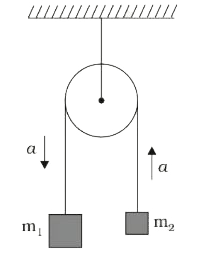Two bodies of different masses are dropped similtaneously from the top of a tower .If air resistance is proportional to the mass of the body.
the heavier body reaches the ground earlier
the lighter body reaches the ground earlier
both reach the ground simultaneously
cannot be decided
The correct Answer is:A
To solve the problem of two bodies of different masses being dropped simultaneously from the top of a tower, we need to analyze the forces acting on each body and how these forces affect their motion. Here’s a step-by-step solution:
Step 1: Identify the Forces Acting on the Bodies
When a body is dropped, two main forces act on it:
- The gravitational force (weight) acting downwards, which is given by Fg=mg, where m is the mass of the body and g is the acceleration due to gravity.
- The air resistance acting upwards, which is proportional to the mass of the body. We can express this as Fair=mα, where α is a constant of proportionality.
Hint: Remember that the gravitational force increases with mass, but so does the air resistance.
Step 2: Write the Equation of Motion
According to Newton's second law, the net force acting on the body can be expressed as:
Fnet=Fg−Fair
Substituting the expressions for Fg and Fair:
Fnet=mg−mα
Step 3: Apply Newton's Second Law
Using Newton's second law, we can relate the net force to the acceleration of the body:
ma=mg−mα
Dividing through by m (assuming m≠0):
a=g−α
Hint: This equation shows that the acceleration a is independent of the mass m.
Step 4: Analyze the Result
From the equation a=g−α, we see that the acceleration a does not depend on the mass of the body. This means that both bodies, regardless of their different masses, will experience the same acceleration as they fall.
Step 5: Conclusion
Since both bodies have the same acceleration and are dropped simultaneously from the same height, they will reach the ground at the same time.
Final Answer: Both bodies will reach the ground simultaneously.
When a body is dropped, two main forces act on it:
- The gravitational force (weight) acting downwards, which is given by Fg=mg, where m is the mass of the body and g is the acceleration due to gravity.
- The air resistance acting upwards, which is proportional to the mass of the body. We can express this as Fair=mα, where α is a constant of proportionality.
According to Newton's second law, the net force acting on the body can be expressed as:
Fnet=Fg−Fair
Substituting the expressions for Fg and Fair:
Fnet=mg−mα
Using Newton's second law, we can relate the net force to the acceleration of the body:
ma=mg−mα
Dividing through by m (assuming m≠0):
a=g−α
From the equation a=g−α, we see that the acceleration a does not depend on the mass of the body. This means that both bodies, regardless of their different masses, will experience the same acceleration as they fall.
Since both bodies have the same acceleration and are dropped simultaneously from the same height, they will reach the ground at the same time.
Topper's Solved these Questions
- MOTION IN A STRAIGHT LINE BOOK - AAKASH SERIESCHAPTER - MOTION IN A STRAIGHT LINE EXERCISE - EXERCISE -II
80 Videos
- MOTION IN A STRAIGHT LINE BOOK - AAKASH SERIESCHAPTER - MOTION IN A STRAIGHT LINE EXERCISE - PRACTICE EXERCISE
58 Videos
- MOTION IN A STRAIGHT LINE BOOK - AAKASH SERIESCHAPTER - MOTION IN A STRAIGHT LINE EXERCISE - very Short answer type question
15 Videos
- MOTION IN A PLANEBOOK - AAKASH SERIESCHAPTER - MOTION IN A PLANEEXERCISE - QUESTION FOR DESCRIPTIVE ANSWER
7 Videos
- MOVING CHARGES AND MAGNETISMBOOK - AAKASH SERIESCHAPTER - MOVING CHARGES AND MAGNETISMEXERCISE - EXERCISE-III
49 Videos
Similar Questions
Two bodies of different masses are dropped simultaneously from same height. If air friction acting on them is directly proportional to the square of their mass, then,
View SolutionTwo bodies of masses m1andm2(<m1) are connected to the ends of a massless cord and allowed to move as shown in figure. The pulley is both massless and frictionless. The acceleration of the centre of mass is (m1−m2)n(m1+m2)2g. Find the value of n.

View Solution
Knowledge Check
The centre of mass of a body
Alies always at the geometrical centreBlies always inside the bodyClies always outside the bodyDmay lie within or outside the body
For body thrown horizontally from the top of a tower,
View SolutionWrite the locus of a stone dropped from the top of a tower.
View SolutionTwo bodies of different masses are moving with same kinetic energy. Then, the ratio of their moment is equal to the ratio of their
View SolutionAssertion : Two bodies of unequal masses m1andm2 are dropped from the same height. If the resistance offered by air to the motion of both bodies is the same, the bodies will reach the earth at the same time.
Reason : For equal air resistance, acceleration of fall of masses m1andm2 will be different.
View SolutionAssertion: Two bodies of masses M and m(M>m) are allowed to fall from the same height if the air resistance for each be the same then both the bodies will reach the earth simultaneously.
Reason: For same air resistance, acceleration of both the bodies will be same.
View SolutionTwo balls of different masses are thrown in air with different velocities. While they are in air acceleration of centre of mass of the system. (neglect air resistance)?
View SolutionA stone is dropped from the top of a tower. If it hits the ground after 10 seconds, what is the height of the tower?
View Solution
